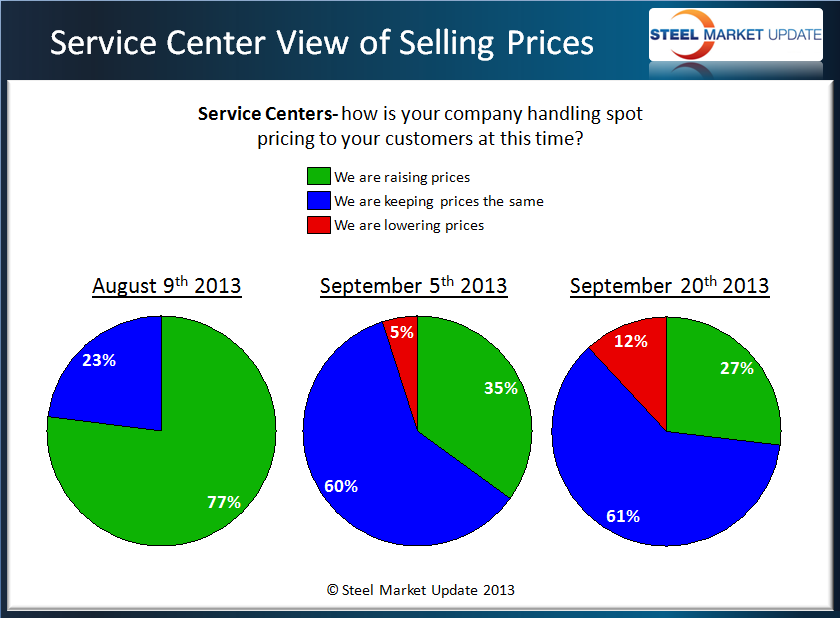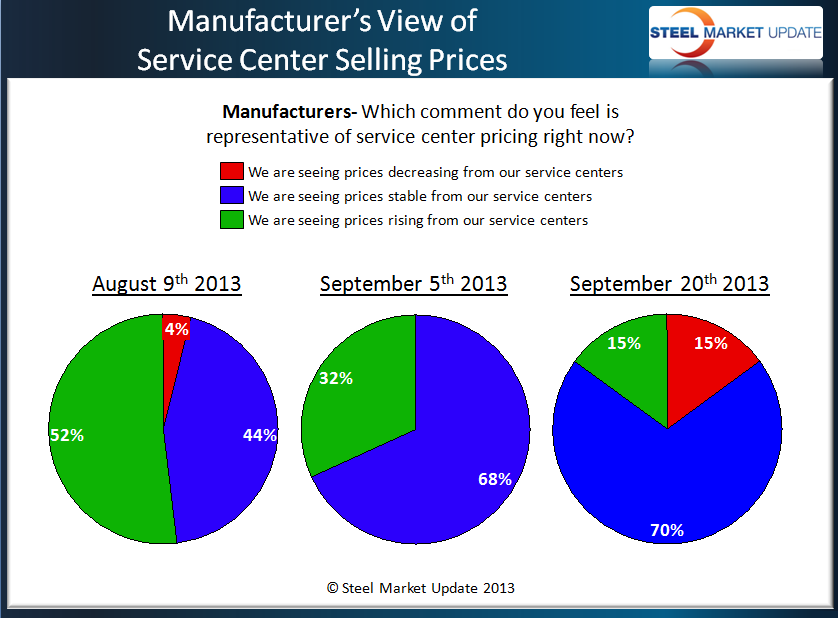SMU Data and Models

Service Center Spot Price Trend Shifting Away from Higher Prices
Written by John Packard
September 22, 2013
We heard it earlier this month when during our HARDI steel conference call the wholesalers complained of reduced margins due to competitive pressures and mentioned that there were a growing number of non-traditional galvanized suppliers competing for the mechanical contractors business.
During last week’s steel market review conducted by Steel Market Update (SMU), manufacturing companies reported seeing as many service centers lowering prices as those attempting to increase spot prices (see graphic). At the beginning of August a majority of manufacturing companies reported their service center buyers raising spot prices. Since then, the percentage shrank to 32 percent at the beginning of September and is now at 15 percent. The majority of manufacturing companies are reporting spot prices as being stable. By the way, the thumbnail graphics are “clickable” which will blow up the size for you to be able to read them better
The percentage of service centers reporting their spot prices as dropping increased from 5 percent at the beginning of September to 12 percent this past week. The percentage of distributors raising prices shrank from 35 percent to 27 percent while those reporting spot prices as remaining the same remained steady at 61 percent last week compared to 60 percent at the beginning of the month.
 Steel Market Update believes the strength of the service center spot pricing is directly related to the ability of the domestic steel mills to collect price increases. The trend, at this moment, is moving away from distributors raising spot prices, most likely due to the belief that excess inventory will soon enter the market in the form of USS Lake Erie Works, ThyssenKrupp and AK Steel catching up on their late orders.
Steel Market Update believes the strength of the service center spot pricing is directly related to the ability of the domestic steel mills to collect price increases. The trend, at this moment, is moving away from distributors raising spot prices, most likely due to the belief that excess inventory will soon enter the market in the form of USS Lake Erie Works, ThyssenKrupp and AK Steel catching up on their late orders.
What may work to hold spot prices steady is the maintenance going on at ArcelorMittal, the hot strip mill outage scheduled for December at Nucor Berkeley and planned maintenance at Severstal Dearborn and Columbus.

John Packard
Read more from John PackardLatest in SMU Data and Models

SMU Scrap Survey: Sentiment Indices rise
Both current and future scrap sentiment jumped this month, though survey participants reported responses before key trade news was announced.

SMU Survey: Sentiment splits, buyers have better view of future than the present
SMU’s Steel Buyers’ Sentiment Indices moved in opposite directions this week. After rebounding from a near five-year low in late June, Current Sentiment slipped again. At the same time, Future Sentiment climbed to a four-month high. Both indices continue to show optimism among buyers about their company’s chances for success, but suggest there is less confidence in that optimism than earlier in the year.

SMU scrap market survey results now available
SMU’s ferrous scrap market survey results are now available on our website to all premium members. After logging in at steelmarketupdate.com, visit the pricing and analysis tab and look under the “survey results” section for “ferrous scrap survey” results. Past scrap survey results are also available under that selection. If you need help accessing the survey results […]

SMU flat-rolled market survey results now available
SMU’s latest steel buyers market survey results are now available on our website to all premium members. After logging in at steelmarketupdate.com, visit the pricing and analysis tab and look under the “survey results” section for “latest survey results.” Past survey results are also available under that selection. If you need help accessing the survey results, or if […]

SMU Survey: Sheet lead times stabilize, plate contracts
Mill lead times for sheet products were steady to slightly longer this week compared to our late June market check, while plate lead times contracted, according to steel buyers responding to this week’s market survey.

